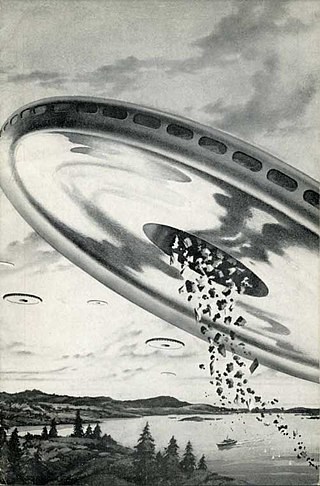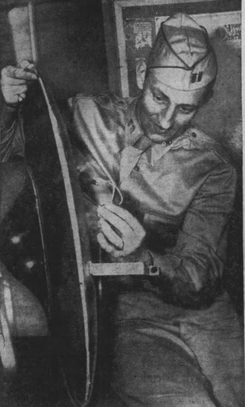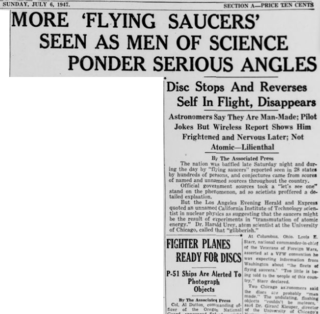
An unidentified flying object (UFO), or unidentified anomalous phenomenon (UAP), is any perceived airborne, submerged or transmedium phenomenon that cannot be immediately identified or explained. Upon investigation, most UAPs are identified as known objects or atmospheric phenomena, while a small number remain unexplained.

The Roswell incident is a collection of events and myths surrounding the 1947 crash of a United States Army Air Forces balloon near Roswell, New Mexico. Operated from the nearby Alamogordo Army Air Field and part of the top secret Project Mogul, the balloon was intended to detect Soviet nuclear tests. After metallic and rubber debris was recovered by Roswell Army Air Field personnel, the United States Army announced their possession of a "flying disc". This announcement made international headlines but was retracted within a day. Obscuring the true purpose and source of the crashed balloon, the Army subsequently stated that it was a conventional weather balloon.
Kenneth Albert Arnold was an American aviator, businessman, and politician.
The extraterrestrial hypothesis (ETH) proposes that some unidentified flying objects (UFOs) are best explained as being physical spacecraft occupied by extraterrestrial intelligence or non-human aliens, or non-occupied alien probes from other planets visiting Earth.

The Maury Island hoax refers to claims made by Fred Crisman and Harold Dahl of falling debris and threats by men in black following sightings of unidentified flying objects in the sky over Maury Island, Washington, United States. The pair claimed that the events had occurred on June 21, 1947.
In ufology, the psychosocial hypothesis, abbreviated PSH, argues that at least some UFO reports are best explained by psychological or social means. It is often contrasted with the better-known extraterrestrial hypothesis (ETH), and is particularly popular among UFO researchers in the United Kingdom, such as David Clarke, Hilary Evans, the editors of Magonia magazine, and many of the contributors to Fortean Times magazine. It has also been popular in France since the publication in 1977 of a book written by Michel Monnerie, Et si les ovnis n'existaient pas?.
Samuel Eaton Thompson was an American contactee who claimed to have been in contact with extraterrestrials. Although his claims earned him little publicity during his lifetime, Thompson might have been the first North American contactee. Researcher Jerome Clark describes the account as "surely the most outlandish story in early UFO history [and] also one of the most obscure". The story earned a brief, 11 paragraph, mention in a local newspaper in 1950, and the full story was not publicized until more than three decades afterwards.

In ufology, conspiracy theory, science fiction, and comic book stories, claims or stories have circulated linking UFOs to Nazi Germany. The German UFO theories describe supposedly successful attempts to develop advanced aircraft or spacecraft prior to and during World War II, further asserting the post-war survival of these craft in secret underground bases in Antarctica, South America, or the United States, along with their creators.
Wallace Tillinghast was a Worcester, Massachusetts businessman, and the originator of an airplane hoax in the early 1900s.

The Gulf Breeze UFO incident was a series of claimed UFO sightings in Gulf Breeze, Florida, United States, during late 1987 and early 1988. Beginning in November 1987, the Gulf Breeze Sentinel newspaper published a number of photos supplied to them by local contractor Ed Walters that were claimed to show a UFO. UFOlogists such as Bruce Maccabee believed the photographs were genuine; however, others strongly suspected them to be a hoax.

The Aurora, Texas, UFO incident reportedly occurred on April 17, 1897, when, according to locals, a UFO crashed on a farm near Aurora, Texas. The incident is claimed to have resulted in a fatality of the pilot. The pilot was "not of this world" and was said to be an alien. The pilot was buried at the Aurora cemetery. A stone was placed as a marker for the grave, but has since been removed.
The Belgian UFO wave was a series of sightings of triangular UFOs in Belgium, which lasted from 29 November 1989 to April 1990.

The Aztec, New Mexico, UFO hoax was a flying saucer crash alleged to have happened in 1948 in Aztec, New Mexico. The story was first published in 1949 by author Frank Scully in his Variety magazine columns, and later in his 1950 book Behind the Flying Saucers. In the mid-1950s, the story was exposed as a hoax fabricated by two con men, Silas M. Newton and Leo A. Gebauer, as part of a fraudulent scheme to sell supposed alien technology. Beginning in the 1970s, some ufologists resurrected the story in books claiming the purported crash was real. In 2013, an FBI memo claimed by some ufologists to substantiate the crash story was dismissed by the bureau as "a second- or third-hand claim that we never investigated".
UFO sightings in outer space are sightings of unidentified flying objects reported by astronauts while in space that they could not explain at the time. These sightings have been claimed as evidence for alien visits by ufologists.

The Twin Falls saucer hoax was a hoaxed flying disc discovered in Twin Falls, Idaho, United States, on July 11, 1947. Amid a nationwide wave of alleged "flying disc" sightings, residents of Twin Falls reported recovering a 30 in (76 cm) "disc". FBI and Army officials took possession of the disc and quickly proclaimed the object to be a hoax. Press reported that local teenagers admitted to perpetrating the hoax.

The Flight 105 UFO sighting occurred on July 4, 1947, when three crew members aboard a United Airlines flight reported seeing multiple unidentified objects in the skies over the Pacific Northwest. A week prior, private pilot Kenneth Arnold had reported seeing similar objects nearby – a sighting that was followed by nearly 800 "copycat" reports during the summer of 1947. Four days after the Flight 105 sighting, Roswell Army Air Field issued a press release stating that they had recovered a "flying disc"; that statement was quickly retracted and it was put forward that the crashed object was identified as a "conventional weather balloon." A statement that would yet again be changed to the now official explanation being a crashed Project Mogul high-altitude balloon, whose primary purpose was long-distance detection of sound waves generated by Soviet atomic bomb tests. The following month, on July 29, an air crew flying the same route also reported unidentified objects.

The 1947 flying disc craze was a rash of unidentified flying object reports in the United States that were publicized during the summer of 1947. The craze began on June 24, when media nationwide reported civilian pilot Kenneth Arnold's story of witnessing disc-shaped objects which headline writers dubbed "Flying Saucers". Such reports quickly spread throughout the United States; historians would later chronicle at least 800 "copycat" reports in subsequent weeks, while other sources estimate the reports may have numbered in the thousands.

The Rhodes UFO photos, sometimes called the shoe-heel UFO photos, are two photos that were reportedly taken on July 7, 1947 by amateur astronomer and inventor William Albert Rhodes. The photographs purport to show a disc-like object flying above Phoenix, Arizona. Rhodes's account and photographs were published by the Arizona Republic on July 9.
The Dundy County UFO hoax was a hoax perpetrated by the Nebraska State Journal in 1884. According to the Journal. a group of cowboys found a long, cylindrical object in Dundy County, Nebraska, near the settlement of Max, after the crash of a meteor. The story was revealed to be a hoax in 1927 by Nebraska State Journal editors, though some continue to believe that the sighting was legitimate.














